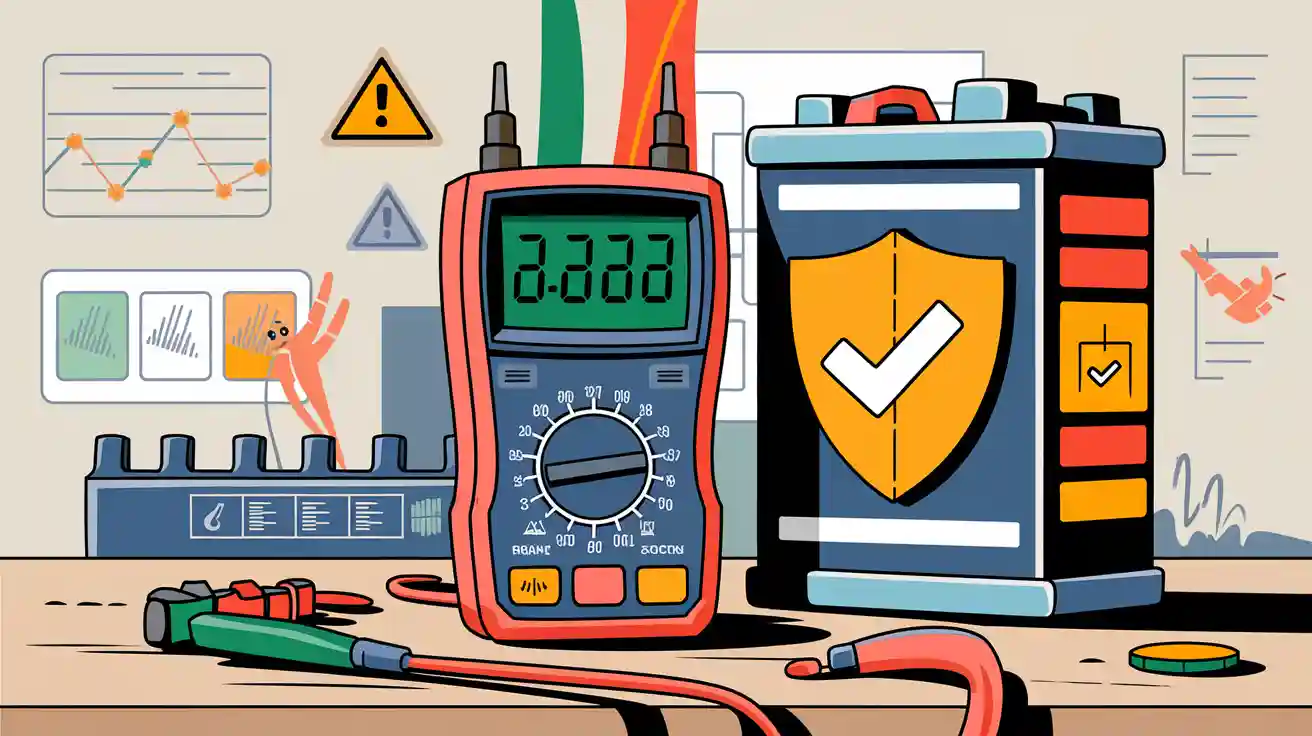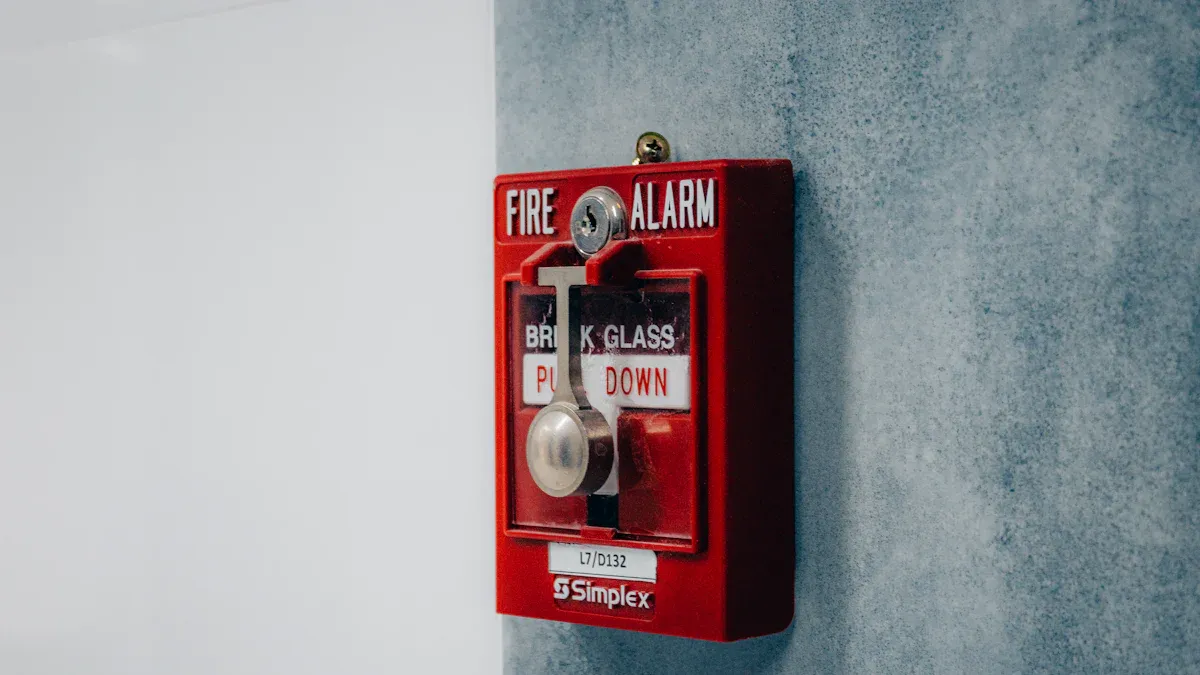
You rely on battery safety and reliability to keep industrial measurement instruments running smoothly. Lithium-ion batteries power these devices, making their dependable operation essential. When batteries fail, you face risks like thermal runaway, mechanical damage from impacts, and manufacturing defects that can compromise both safety and productivity. Fires, explosions, or data loss can halt operations and threaten worker safety. Rigorous testing, robust battery management systems, and strict adherence to lithium-ion battery safety standards help you avoid costly downtime and ensure your batteries support uninterrupted, safe performance.
Key Takeaways
Battery safety is crucial for industrial instruments. Regular inspections and monitoring can prevent failures and ensure smooth operations.
Implement a robust battery management system. This system helps monitor battery health and prevents issues like overcharging and overheating.
Follow strict handling and storage protocols. Store batteries in cool, dry places and check for damage to avoid risks.
Use real-time monitoring technology. Tracking voltage and temperature helps detect problems early and reduces downtime.
Adhere to safety standards. Compliance with recognized standards ensures battery reliability and minimizes hazards in industrial settings.
Part 1: Battery Safety Risks

1.1 Failure Modes
You encounter several failure modes that threaten battery safety in industrial measurement instruments. These risks affect devices in medical, robotics, security systems, infrastructure, and consumer electronics. Common issues include:
Short circuits, often caused by metallic particles, can lead to overheating and even thermal runaway.
Punctures and leakage may result from mechanical stress or sharp objects, causing electrolyte leakage and compromising safety protection.
Swelling can occur due to moisture intrusion, overcharging, or aging, reducing the reliability of batteries.
Battery safety depends on your ability to identify these failure modes early. You must implement safety protection features to prevent these risks from impacting your operations.
1.2 Environmental Stress
Environmental stress plays a major role in battery safety and reliability. You face challenges such as:
Overheating, which can result from external temperature rises or internal short-circuiting.
Chemical leaks, which release toxic substances and pose health risks.
Performance degradation, which affects the reliability of batteries and can lead to functional failures.
Tip: Use battery test chambers to simulate environmental stresses and verify battery safety before deploying batteries in industrial settings.
Temperature extremes can accelerate battery degradation. The table below shows how discharge rate and temperature affect battery performance:
Discharge Rate (C) | Environmental Temperature (°C) | Discharge Performance (%) | Heat Generation (W) |
|---|---|---|---|
1 | -30 | < 70 | 7 |
2 | 20, 30, 40 | > 70 | 7 |
3 | -30 | < 70 | 151.5 |
3 | 40 | 88 | 151.5 |
You must monitor batteries in medical, robotics, and infrastructure applications to maintain battery safety under harsh conditions.
1.3 Impact on Operations
Battery failure can disrupt industrial measurement instruments and cause significant downtime. You risk losing data integrity and operational uptime in critical sectors such as healthcare, telecommunications, and security systems. Reliable batteries and robust safety protection systems are essential for continuous operation. When batteries fail, you may experience productivity interruptions and inaccurate data collection. Battery safety ensures your instruments deliver consistent performance and protect your business from costly disruptions.
Part 2: Battery Management Systems
Battery safety in industrial measurement instruments depends on advanced battery management system design. You need a battery management system to monitor, control, and protect lithium battery packs in demanding environments. These systems play a critical role in preventing overcharging, over-discharging, and thermal events, which can threaten battery safety and disrupt operations in sectors like medical devices, robotics, security systems, and infrastructure.
2.1 BMS Architecture
A robust battery management system architecture gives you the tools to maintain battery safety and reliability. You rely on several key components to ensure safe operation of lithium battery packs, including LiFePO4, NMC, LCO, LMO, LTO, solid-state, and lithium metal chemistries. The table below outlines the main elements of a battery management system:
Component | Description |
|---|---|
Battery cell monitor | Monitors individual cell voltages to determine the battery pack’s charge and ensure safety. |
Cutoff FETs | Manages connection and isolation between load and charger, predicting behavior through measurements. |
Monitoring of Temperature | Ensures safe operation by monitoring temperature to prevent catastrophic failures. |
Cell voltage balance | Maintains health of the battery pack by ensuring cells operate within safe voltage ranges. |
BMS Algorithms | Processes data from sensors to make real-time decisions for battery management. |
Real-Time Clock | Provides time-stamping and memory storage for monitoring battery behavior over time. |
You use individual cell monitoring to track each cell’s voltage and temperature. This approach helps you prevent overcharging and over-discharging, which can damage batteries and reduce their lifespan. BMS devices also provide cell balancing, which keeps all cells at similar voltage levels. This process maximizes usable capacity and improves battery safety.
A well-designed battery management system monitors battery characteristics and communicates health status. You can avoid capacity loss and battery damage by using internal protection controls. These controls help you manage temperature extremes, prevent shorts, and protect against under and over voltage. In industrial measurement instruments, you need these features to maintain battery safety and ensure uninterrupted operation.
Note: For more details on battery management systems and their role in industrial lithium battery packs, visit the BMS and PCM page.
2.2 Redundancy and Partitioning
You can enhance battery safety and reliability by using redundancy and partitioning strategies in your battery management systems. Modular and distributed battery management system architectures allow you to scale your system and improve fault tolerance. Each module or cell controller operates independently, so you can expand or contract your system as needed.
The primary advantage of a modular battery management system lies in its scalability and flexibility. Since each module functions independently, you can expand or contract the system by adding or removing modules. This feature not only enhances scalability but also boosts system reliability, as it enables the system to continue functioning even in the event of module failure. The inherent scalability and redundancy of a distributed battery management system is its main benefit. The system may be scaled by simply adding or removing cells and their accompanying controllers because each cell or module has its own controller. Fault tolerance allows the system to function even if a single node fails, although the system will function with decreased functionality.
You should consider the following strategies to reduce the risk of single-point failures:
Use modular battery management systems to allow independent module operation.
Choose distributed battery management systems for fault tolerance and precise cell monitoring.
Ensure redundancy is independent, with separate power supplies, logic processing, and diagnostics.
Avoid common cause failures by not sharing power supplies or monitoring systems between redundant components.
Centralized battery management systems are simple but introduce a single point of failure. Distributed and modular battery management systems offer better fault isolation and customization. In large-scale industrial applications, such as robotics or infrastructure monitoring, these approaches help you maintain battery safety and system uptime.
2.3 BMS ICs and Testing
You depend on advanced bms ic technology to achieve high levels of battery safety and reliability. Recent innovations in bms ic design, such as the NXP BMx7318 and BMx7518 families, support up to 18 battery cells and track up to 12 temperature sensors at once. These bms ic devices measure cell voltages with 1 mV accuracy and provide integrated current sensing. They also support passive cell balancing, which maximizes usable capacity and extends battery life.
Feature | Description |
|---|---|
New IC Family | NXP introduced the BMx7318 and BMx7518, a new family of 18-channel battery-cell controller ICs. |
Voltage Measurement | Can measure voltages in up to 18 battery cells simultaneously. |
Temperature Tracking | Tracks up to 12 temperature sensors at the same time. |
Accuracy | Measures cell voltages to within 1 mV. |
Current Sensing | Integrated current sensing through a separate shunt resistor. |
Safety Compliance | Complies with ASIL C and SIL-2 standards for functional safety. |
Cell Balancing | Supports passive cell balancing to maximize usable capacity. |
Advanced Architecture | Features advanced analog front-end architecture for reduced crosstalk and improved accuracy. |
EMI Immunity | Designed to deter electromagnetic interference (EMI). |
Cost Efficiency | Reduces external component count by up to 50%, saving space and costs for OEMs. |
Power Consumption | Ultra-low-power mode consuming only 5 µA for long-term energy storage. |
You face several challenges when testing bms ic devices for compliance and reliability. You must ensure accurate measurements under various conditions, manage electromagnetic interference, and achieve compliance with strict industry standards. In industrial measurement instruments, you need bms ic solutions that deliver precise individual cell monitoring, robust cell balancing, and reliable performance in harsh environments.
Bms ic technology supports battery safety by enabling real-time monitoring, advanced diagnostics, and predictive maintenance. In medical devices, robotics, and security systems, you rely on these features to prevent failures and maintain continuous operation. Bms devices with advanced cell balancing and individual cell monitoring help you extend battery life and reduce maintenance costs.
Tip: Choose bms ic devices that comply with ASIL C and SIL-2 standards for functional safety in critical industrial applications.
Part 3: Battery Safety Testing

3.1 Testing Methods
You need to use advanced battery safety testing methods to ensure lithium battery packs in industrial measurement instruments meet strict safety requirements. Battery safety testing includes short circuit tests, temperature cycling, thermal abuse tests, and crush and puncture tests. These methods help you identify weaknesses in batteries used in medical, robotics, security systems, and infrastructure applications.
Here is a table showing the most widely used battery safety testing standards and their key tests:
Standard | Description | Key Tests |
|---|---|---|
UL 1642 | Standard for Lithium Batteries developed by Underwriters Laboratories. | Short circuit, Temperature cycling |
IEC 62133 | Main international safety standard for rechargeable lithium batteries. | Thermal abuse, Temperature cycling |
UL 2054 | Guidelines for lithium cell and battery pack safety. | Short circuit, Crush and puncture |
UN 38.3 | Safety testing requirements for batteries in transportation. | Various transport tests |
SAE J2464 | Primary EV battery safety test standard. | Crash and failure tests |
You must use accelerated life testing and abuse testing to assess battery safety in industrial environments. These protocols include thermal stability, electrical safety, and mechanical integrity. Abuse testing focuses on thermal runaway resistance and overcharge protection, which are critical for battery safety.
Tip: Align your battery safety testing protocols with evolving standards to ensure reliable safety assessments and regulatory compliance.
3.2 Standards (IEC 62619, UL, ISO)
You must follow recognized standards to achieve battery safety and compliance for lithium battery packs. IEC 62619, UL, and ISO standards specify requirements for safe operation in industrial measurement instruments. These standards cover short circuit, impact, drop, thermal abuse, overcharge, and forced discharge tests.
Test Type | Description | Clause Reference |
|---|---|---|
Short Circuit | A short-circuit between terminals will not cause fire or explosion | IEC 62619 Cl. 7.2.1 |
Impact | An impact on the cell shall not lead to explosion or fire | IEC 62619 Cl. 7.2.2 |
Drop Test | A drop of a cell block will not result in explosion or fire | IEC 62619 Cl. 7.2.3 |
Thermal Abuse | Elevated temperature will not lead to explosion or fire | IEC 62619 Cl. 7.2.4 |
Overcharge | Charging beyond specified time will not cause fire or explosion | IEC 62619 Cl. 7.2.5 |
Propagation/Internal Thermal Event | An internal short-circuit will not lead to fire of the whole battery system | IEC 62619 7.3.3 |
Overcharge with Voltage | The Battery Management System (BMS) will control charging voltage | IEC 62619 8.2.2 |
Overheating Control | The BMS will stop charging if temperature exceeds limits | IEC 62619 8.2.4 |
Compliance with IEC 62619 and UL standards enhances battery safety, reliability, and performance. These certifications help you access global markets and build trust with industrial clients. Proper safety certification minimizes risks of fire, explosion, and electrical hazards.
3.3 Testing Equipment
You need specialized testing equipment to conduct comprehensive battery safety testing. Electrical tests assess battery performance and safety under different conditions. Mechanical tests evaluate resilience to impact and structural integrity. Environmental tests examine battery safety across temperature and humidity extremes.
Type of Test | Description |
|---|---|
Electrical Tests | Assess battery performance and safety under various conditions. |
Mechanical Tests | Evaluate resilience to physical impacts and structural integrity. |
Environmental Tests | Examine performance under extreme conditions like temperature and humidity. |
You should use battery safety test chambers for temperature cycling and heating tests. Precision measurement technologies improve the accuracy and reliability of battery safety testing. These tools help you detect flaws in battery design and maintain high safety standards. Advanced testers like the EA-BT 20000 Triple Battery Tester allow you to measure dynamic responses and ensure safe operation of LiFePO4, NMC, LCO, LMO, LTO, solid-state, and lithium metal batteries.
Note: Consistent, high-level measurements reduce recalibration needs and minimize production downtime, supporting battery safety in industrial measurement instruments.
Part 4: Best Practices and Solutions
4.1 Handling and Maintenance
You can improve battery safety by following strict handling and maintenance protocols for lithium battery packs in industrial measurement instruments. Always store batteries in a cool, dry place with stable temperatures and low humidity. Use protective covers and non-conductive containers to prevent short-circuits and physical damage. When storing batteries long-term, keep them at about 50% charge and check them regularly for leaks, bulges, or corrosion. Avoid inactivity by cycling batteries occasionally, even when not in use.
Store batteries away from direct sunlight and heat sources.
Inspect batteries for cracks, leaks, or other signs of damage before use.
Clean terminals with a wire brush and baking soda solution to prevent corrosion.
Train your staff on safe handling practices and invest in batteries from reputable manufacturers.
Common mishandling incidents often result from overheating, short circuits, or exposure to external heat sources. You can prevent these risks by following manufacturer guidelines and maintaining a regular inspection schedule.
For responsible sourcing, ensure your supply chain aligns with ethical standards. Review your supplier’s conflict minerals policy to support sustainable practices. Read our conflict minerals statement.
4.2 Real-Time Monitoring
Real-time monitoring plays a vital role in battery safety for industrial measurement systems. By tracking voltage, current, and temperature, you can detect early signs of failure and prevent costly downtime. Advanced sensors, such as dynamic impedance spectroscopy and wireless monitoring solutions, provide accurate data on battery state of charge and health.
Technology/Sensor Type | Description |
|---|---|
Temperature Sensors | Prevent overheating by monitoring battery temperature. |
Voltage and Current Sensors | Assess battery health and performance. |
Wireless Monitoring | Enable flexible deployment in industrial environments. |
Data Analytics Integration | Support predictive maintenance and lifespan management. |
Real-time insights help you predict maintenance needs and optimize battery replacement schedules. This approach reduces unplanned downtime, which costs manufacturers billions each year. You gain faster decision-making and improved operational efficiency.
4.3 Process Instrumentation
Modern process instrumentation enhances battery safety by delivering precise measurements and immediate alerts. You can integrate environmental sensors to monitor temperature and humidity, ensuring optimal conditions for lithium battery packs. Advanced data analysis tools support predictive maintenance and help you optimize battery performance in medical, robotics, security systems, and infrastructure applications.
Feature | Benefit |
|---|---|
Precise measurement | Prevents mismanagement of charge and capacity. |
Real-time monitoring | Detects overheating or overcharging instantly. |
Alarm capabilities | Sends alerts for unsafe operational limits. |
You can use computational methods like support vector regression, neural networks, and hybrid models to predict battery failures and schedule maintenance. These tools analyze complex data patterns, helping you extend battery life and maintain high safety standards across all industrial sectors.
You protect your industrial measurement instruments by prioritizing battery safety. Proactive measures like monitoring key parameters, using impedance measurement, and adding redundancy in monitoring systems help you prevent failures. Advanced battery management systems and strict compliance with industry standards reduce risks in medical, robotics, security systems, and infrastructure applications. When you follow best practices, you gain cost efficiency, operational continuity, and performance optimization.
Regular inspections, temperature management, proper charging, and secure storage all support battery safety. You extend battery life and minimize downtime by calibrating systems and preventing physical stress.
Proactive Measure | Description |
|---|---|
Monitoring Key Parameters | Check voltage, current, and temperature to prevent thermal runaway and cell damage. |
Impedance Measurement | Diagnose battery health early to avoid critical failures. |
Redundancy in Monitoring Systems | Use secondary systems to verify primary monitoring and enhance battery safety. |
Balance Complexity and Safety | Focus on essential sensors for reliable battery safety. |
Checklist for Battery Safety in Industrial Environments:
Conduct regular inspections for damage and corrosion.
Manage temperature with cooling systems.
Use proper charging practices and compatible chargers.
Optimize storage conditions for lithium battery packs.
Calibrate and test battery management systems.
Prevent physical stress and follow manufacturer guidelines.
You ensure battery safety and reliability by following these steps. Your operations benefit from fewer disruptions, better performance, and improved safety.
FAQ
What lithium battery chemistries are best for industrial measurement instruments?
Chemistry | Platform Voltage (V) | Energy Density (Wh/kg) | Cycle Life (cycles) |
|---|---|---|---|
LiFePO4 | 3.2 | 120–160 | 2000–5000 |
NMC | 3.7 | 150–220 | 1000–2000 |
LCO | 3.7 | 150–200 | 500–1000 |
LMO | 3.7 | 100–150 | 300–700 |
LTO | 2.4 | 70–80 | 7000–20000 |
Solid-state | 3.7 | 250–400 | 2000–5000 |
Lithium metal | 3.7 | 350–500 | 500–1000 |
You should select LiFePO4 or LTO for long cycle life and safety in industrial, medical, or infrastructure applications.
How do you prevent battery failure in harsh environments?
You monitor temperature, voltage, and current using real-time sensors. You use battery management systems with redundancy. You store batteries in cool, dry places. You follow strict maintenance schedules. These steps help you avoid failures in robotics, security systems, and industrial sectors.
What standards ensure lithium battery safety for industrial use?
You follow IEC 62619, UL 1642, and ISO standards. These standards require tests for short circuits, thermal abuse, and mechanical impact. You ensure compliance to reduce risks in medical, infrastructure, and industrial measurement instruments.
Why is real-time monitoring important for lithium battery packs?
Real-time monitoring detects early signs of overheating, overcharging, or cell imbalance. You use advanced sensors and analytics to prevent downtime and extend battery life. This approach supports predictive maintenance in industrial and security systems.
How does battery management system architecture improve reliability?
You use modular and distributed battery management systems. Each module operates independently, allowing you to scale and isolate faults. This architecture increases uptime and safety in industrial measurement instruments and robotics.






